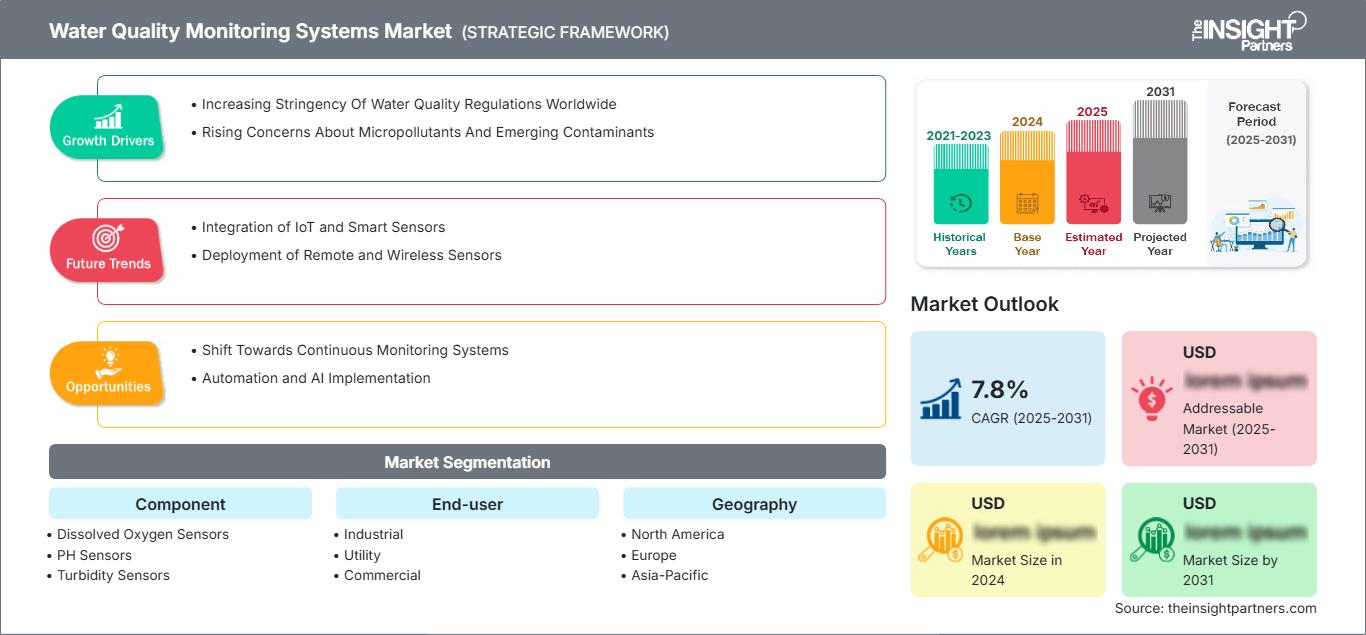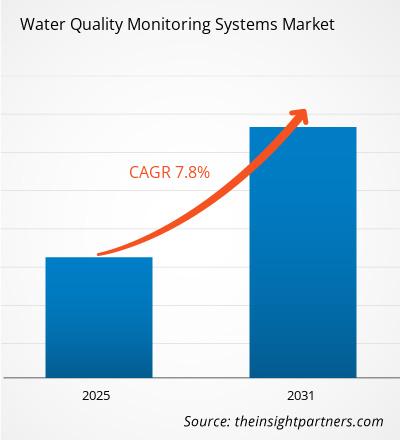水質監視システム市場は、2025年から2031年にかけて年平均成長率7.8%で成長し、市場規模は2024年のXX百万米ドルから2031年にはXX百万米ドルに拡大すると予想されています。
レポートは、コンポーネント(溶存酸素センサー、PHセンサー、濁度センサー、温度センサー、TOC分析装置、その他)、エンドユーザー(産業、公益事業、商業、住宅)別にセグメント化されています。グローバル分析は、地域レベルおよび主要国別にさらに細分化されています。レポートでは、上記の分析とセグメントの値を米ドルで提供しています。
レポートの目的
The Insight Partnersによるレポート「水質監視システム市場」は、現在の状況と将来の成長、主な推進要因、課題、および機会を説明することを目的としています。これにより、次のようなさまざまなビジネス関係者に洞察が提供されます。
- テクノロジープロバイダー/メーカー: 進化する市場のダイナミクスを理解し、潜在的な成長機会を把握して、情報に基づいた戦略的決定を下せるようにします。
- 投資家: 市場の成長率、市場の財務予測、バリューチェーン全体に存在する機会に関する包括的なトレンド分析を実施します。
- 規制機関: 乱用を最小限に抑え、投資家の信頼と信用を維持し、市場の完全性と安定性を維持することを目的として、市場におけるポリシーと警察活動を規制します。
水質監視システム市場のセグメント化コンポーネント
- 溶存酸素センサー
- pHセンサー
- 濁度センサー
- 温度センサー
- TOC分析装置
- その他
エンドユーザー
- 産業用
- 公益事業用
- 商業用
- 住宅用
レポートの一部、国レベルの分析、Excelデータパックなどを含め、スタートアップ&大学向けに特別オファーや割引もご利用いただけます(無償)
水質監視システム市場: 戦略的洞察

- このレポートの主要な市場動向を入手してください。この無料サンプルには、市場動向から見積もりや予測に至るまでのデータ分析が含まれます。
水質監視システム市場の成長要因
- 世界的に水質規制が厳格化:政府や環境機関は水質パラメータに対するより厳しい基準を設けており、産業界、公共事業体、自治体は包括的な監視ソリューションの導入を求めています。これらの規制では、さまざまな水質パラメータの定期的な検査、リアルタイム監視、詳細な報告が義務付けられることが多く、組織は高度な監視システムへの投資を迫られています。重い罰金や法的措置を回避しながらこれらの規制を遵守する必要性から、組織は既存の監視インフラをより高度で正確かつ信頼性の高いシステムにアップグレードする必要があり、市場の大幅な成長が促進されています。
- 微量汚染物質と新興汚染物質への懸念の高まり:医薬品、パーソナルケア製品、マイクロプラスチック、内分泌攪乱物質などの微量汚染物質や新興汚染物質に対する意識と懸念の高まりが、水質監視システム市場を大きく牽引しています。微量に存在しながらも人体や生態系に有害となる可能性のあるこれらの汚染物質の検出と分析には、高感度で高度な監視機器が必要です。これらの新興汚染物質を特定、追跡、測定するニーズの高まりにより、検出能力を強化した先進的な監視技術の開発と導入が推進されています。
水質監視システム市場の将来動向
- IoTとスマートセンサーの統合:IoTとスマートセンサーの統合により、遠隔監視、即時アラート、自動データ収集が可能になり、水質監視業務の効率と効果が大幅に向上します。IoT接続機能を備えたスマートセンサーは、中央監視ステーションにリアルタイムでデータを送信できるため、水質問題への迅速な対応とより適切な意思決定が可能になります。また、この統合により、予知保全が容易になり、運用コストが削減され、より包括的なデータ分析が可能になります。
- リモートセンサーとワイヤレスセンサーの導入:リモートセンサーとワイヤレスセンサーは、特にアクセスが困難な場所の水質監視システムでますます利用されています。これらのセンサーはワイヤレスでデータを収集・送信できるため、現場訪問の必要性が軽減されます。この傾向により、データ収集の効率が向上し、メンテナンスコストが削減され、水質管理における遠隔意思決定がサポートされます。
水質監視システムの市場機会
- 継続的な監視システムへの移行:継続的な監視は、水質パラメータに関するリアルタイムデータを提供し、汚染イベントの即時検出と品質問題への迅速な対応を可能にします。この移行は、よりタイムリーで包括的な水質データ、運用効率の向上、規制遵守の向上の必要性によって推進されています。組織は、水質パラメータを24時間365日監視できる継続的な監視ソリューションへの投資を増やしており、高度な監視システムに対する持続的な需要を生み出し、システム機能の向上とアプリケーションの拡張を通じて市場成長の新たな機会を生み出しています。
- 自動化とAIの実装:AIを活用したシステムは、膨大な量の水質データを分析してパターンを特定し、潜在的な問題を予測し、是正措置を推奨することができます。自動化は人的ミスを減らし、一貫した監視を可能にし、より高度なデータ分析とレポート作成を可能にします。これらのテクノロジーは、リソースの割り当てを最適化し、意思決定を改善し、予測メンテナンスを可能にする大規模な監視運用に特に役立ちます
水質監視システム市場の地域別分析
予測期間を通じて水質監視システム市場に影響を与える地域的な動向と要因については、The Insight Partnersのアナリストが詳細に解説しています。このセクションでは、北米、ヨーロッパ、アジア太平洋、中東・アフリカ、中南米における水質監視システム市場のセグメントと地域についても解説しています。
水質監視システム市場レポートの範囲
| レポート属性 | 詳細 |
|---|---|
| の市場規模 2024 | US$ XX million |
| 市場規模別 2031 | US$ XX Million |
| 世界的なCAGR (2025 - 2031) | 7.8% |
| 過去データ | 2021-2023 |
| 予測期間 | 2025-2031 |
| 対象セグメント |
By コンポーネント
|
| 対象地域と国 | 北米
|
| 市場リーダーと主要企業の概要 |
|
水質監視システム市場のプレーヤー密度:ビジネスダイナミクスへの影響を理解する
水質モニタリングシステム市場は、消費者の嗜好の変化、技術の進歩、製品メリットへの認知度の高まりといった要因によるエンドユーザーの需要増加に牽引され、急速に成長しています。需要の増加に伴い、企業は製品ラインナップの拡充、消費者ニーズへの対応のための革新、そして新たなトレンドの活用を進めており、これが市場の成長をさらに加速させています。

- 入手 水質監視システム市場 主要プレーヤーの概要
主なセールスポイント
- 包括的な調査範囲:本レポートは、水質監視システム市場における製品、サービス、種類、エンドユーザーの分析を包括的に網羅し、包括的な展望を提供しています。
- 専門家による分析:本レポートは、業界の専門家とアナリストの深い理解に基づいて作成されています。
- 最新情報:本レポートは、最新の情報とデータ動向を網羅しているため、ビジネスの関連性を保証します。
- カスタマイズオプション:本レポートは、特定のクライアントの要件に対応し、ビジネス戦略に適切に適合するようにカスタマイズできます。
したがって、水質監視システム市場に関する調査レポートは、業界のシナリオと成長見通しを解読し理解するための先導役となります。いくつかの妥当な懸念事項があるかもしれませんが、本レポートの全体的なメリットは、デメリットを上回る傾向があります。
- 過去2年間の分析、基準年、CAGRによる予測(7年間)
- PEST分析とSWOT分析
- 市場規模価値/数量 - 世界、地域、国
- 業界と競争環境
- Excel データセット
最新レポート
関連レポート
お客様の声
購入理由
- 情報に基づいた意思決定
- 市場動向の理解
- 競合分析
- 顧客インサイト
- 市場予測
- リスク軽減
- 戦略計画
- 投資の正当性
- 新興市場の特定
- マーケティング戦略の強化
- 業務効率の向上
- 規制動向への対応




















 無料サンプルを入手 - 水質監視システム市場
無料サンプルを入手 - 水質監視システム市場